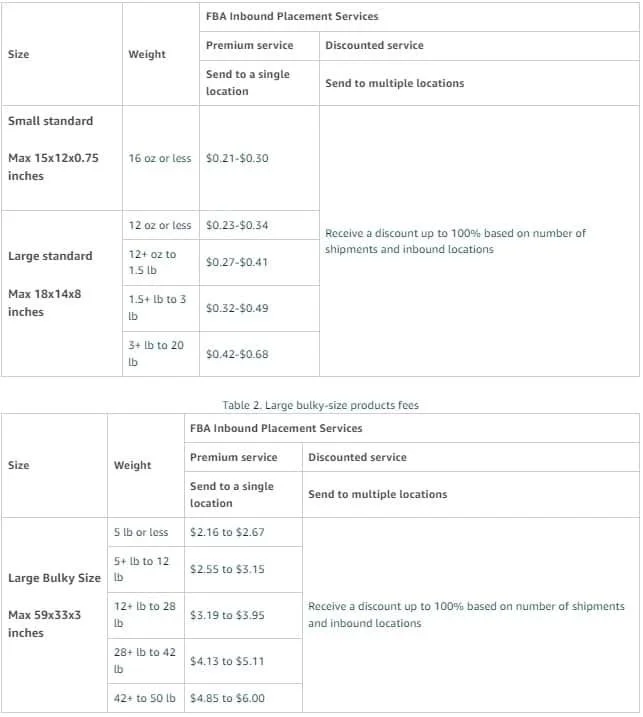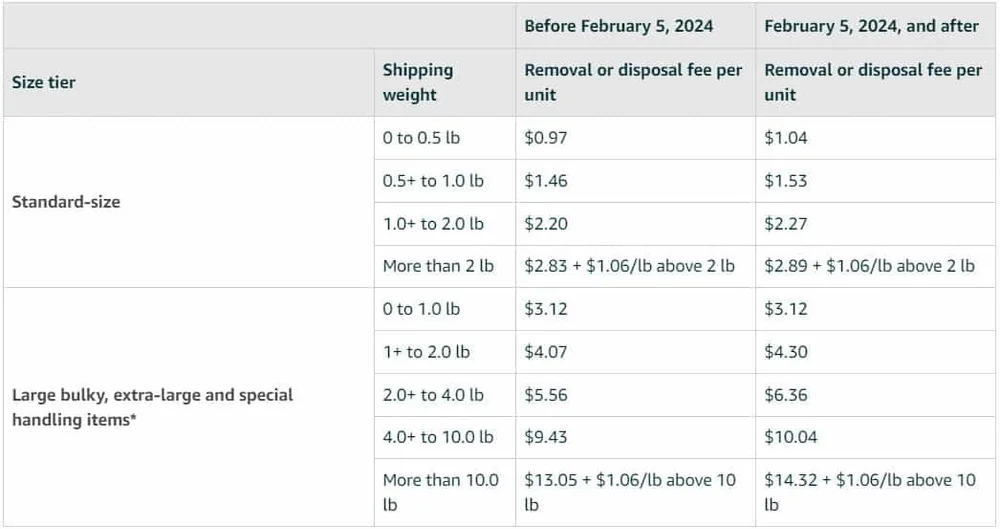Amazon recently announced the Amazon FBA fee changes for 2024. Understanding Fulfillment by Amazon’s current fees and costs is key to informing pricing and inventory management decisions. In 2024, Amazon will implement fee changes focused on improving fulfillment service...
Amazon recently announced the Amazon FBA fee changes for 2024. Understanding Fulfillment by Amazon’s current fees and costs is key to informing pricing and inventory management decisions. In 2024, Amazon will implement fee changes focused on improving fulfillment service and speed to customers while reducing collective cost. Amazon FBA Fees will continue to remain on average 70% less expensive than comparable two-day shipping methods. There will be an increase in the granularity of fee structures this year to offer a more tailored cost structure to each Amazon Seller. Understanding these metrics is important for meeting your sales, cost, and profitability goals in 2024. In this article we will discuss year-over-year changes for common FBA fees and costs like FBA Fulfillment Fees, Storage Fees, Long Term Storage Fees, and Removal Fees as well as some new program features for 2024.
Get help calculating your Amazon feesChanges to FBA Inventory Inbounding and Placement 2024
Amazon will offer updated and revamped inventory Inbounding and Placement fees starting March 1, 2024 with the idea of sharing the cost of distributing inventory across their fulfillment network. When creating a shipping plan the inbounding placement fee will be a more prominent setting where sellers need to choose between:
Premium Service: The shipping plan is sent to a single Receive Center or Fulfillment Center and Amazon where they will distribute inventory across the fulfillment network, for a fee. The premium service fee may vary by inbound location, but Amazon noted there will be higher fees for shipments sent to locations in the West versus other parts of the country.
Discounted Service: Using the discounted service, you will send inventory to multiple inbound locations yourself, for a reduced fee or no fee. The discount will depend on several factors such as number of shipments and inbound locations you send your inventory to. It is noted that in certain situations this discounted service may not be an option.
The Inbounding and Placement fee on average, will be $0.27 per unit for standard-sized products and $1.58 per unit for Large Bulky-sized products and are charged 45 days after products are received. However, the size, weight, and service will place you in a specific tier and fees:

Amazon FBA Inbound Placement Service Fee Chart
Historically, through the FBA Inventory Placement Service (ending 2/29/2024), sellers could send FBA shipments to a single location for a fee, but by default Amazon would split the shipping plan into multiple shipments to spread inventory across their distribution network. It is important to recognize that unless you used Amazon’s previous FBA Inventory Placement Service on FBA shipments, this is an additional fee that needs to be accounted for. Sellers that use Amazon Warehousing & Distribution (AWD) from Supply Chain by Amazon will pay no inbounding fees, which adds increased value to the upstream inventory storage service.
Changes to Amazon FBA Fulfillment Fee 2024
There are a few changes to the Amazon Fulfillment Fees for 2024. On average, Amazon will decrease FBA fulfillment fee rates for standard-sized products by $0.20 per unit and for Large Bulky-sized products by $0.61 per unit. The biggest change this year around the Amazon FBA Fulfillment Fee is the more granular approach to the FBA Size Tiers. By creating a more granular size tier, a seller that was previously on the low end of a particular size tier will benefit from this change. Here is the Size tier and fulfillment Fee card for 2024 for Amazon FBA Fulfillment Fees (excluding Apparel products):

Amazon FBA Fulfillment Fees (excluding Apparel)
These changes will be rolled out in 2 phases, with FBA Fee Rates changing on February 5th, 2024, and April 15th, 2024. The first phase will be adding the new granular tiers, with the second phase being an across the board fee reduction on average of 4% across size tiers. The tier Large standard 4 oz or less will receive the largest reduction at 5%. The tier Large standard 2.75+ to 3lb will receive the smallest reduction at 3%
New Seller Central Ships in Product Packaging (SIPP) Cost Saving Program 2024
The Ships in Product Packaging (SIPP) is a new cost savings program opportunity, which appears to be a rebranding of Amazon’s SIOC (Ships in Own Container) program, which is a part of Amazon Frustration-Free Packaging initiative. SKUs enrolled in the program are eligible to receive a discount of $0.04 to $1.32, depending on SKU size and weight. Focusing on packaging improvements will reduce costs by ensuring products have a minimal viable amount of packaging materials that still have the appropriate strength level to reduce damage in transit on top of the cost savings discount incentive provided by Amazon. Depending on the product, sellers are able to self-test products and record results to enroll in the SIPP program.
Changes to Inventory and FBA Monthly Storage Fees 2024
Amazon will be updating inventory and FBA monthly storage fee changes for 2024. This section will highlight the changes to the FBA monthly storage fee and the new low-level inventory fee.
2024 FBA Monthly Storage Fees
The Monthly Storage Fee is a per cubic foot fee that is charged by Amazon FBA based on your usage of their warehouse storage space. During the holiday period (October - December) storage fees increase as demand for FBA storage increases alongside customer demand. Standard-size products and Large Bulky / Extra-large products are charged at different rates.
In 2024 FBA Monthly Storage Fees will generally remain unchanged aside from a decrease during the Non-Peak period of January through September for Standard-size products. The fee will reduced by $0.09 ($0.87 to $0.78) per cubic square foot. Sellers can reduce the Monthly Storage Fees, by reviewing the space efficiency of their packaging in storage and avoiding carrying inventory excess to customer demand.

Amazon FBA Monthly Inventory Storage Fee Changes 2024
New Low-Inventory-Level Fee
A new fee for Amazon Sellers this year is the Low-Inventory-Level fee, which will be charged when sellers fail to maintain on hand inventory to meet 28 historical days of supply. Amazon is adding this fee because when sellers carry low inventory relative to unit sales, it inhibits Amazon’s ability to distribute products across the FBA network, degrading delivery speed for Amazon customers and increasing shipping costs for Amazon. This new fee will go into effect April 1, 2024.
There are some situations where sellers can be exempt from this fee. Amazon will be reducing non-peak monthly storage fees by an average of .09 per cubic foot to help accommodate this new fee, including:
New-to-FBA parent products for the first 180 days after the first inventory-received date. Sellers need to be enrolled in FBA New Selection to get this benefit.
New professional sellers, for the first 365 days after the first inventory-received date.
Products that are auto-replenished by Amazon Warehousing and Distribution. This provides additional value to the AWD service.
See below for detailed fee rates.

Amazon FBA Low-Inventory-Level Fee 2024
Changes to Storage Utilization and Long Term Storage Fees 2024
This section will discuss the Monthly Inventory Storage fees and Long Term Storage Fee changes for 2024.
Storage Utilization Surcharge
Starting on April 1, 2024, Amazon will be making changes to Storage utilization surcharges. Amazon charges a storage utilization surcharge when sellers overstock inventory compared to recent demand and sell-through in Fulfillment Centers. This ensures that there is storage capacity for available inventory that is in high demand by customers, and it discourages sellers from overstocking inventory and wasting storage space. The surcharge is calculated by variables including Product Size Tier, Current Month, Product Volume, Average Daily Units Stored, Storage Utilization Ratio, and Dangerous Good Classification. Sellers can view their current storage utilization ratio in the FBA dashboard page of Seller Central.
New more granular storage utilization ratios will be added this year to align surcharges more closely to stocking behavior. There will be a total of 6 storage utilization ratios (up from 2 last year) ranging from 22 weeks to 52+ weeks. These new ratios will result in Sellers receiving a surcharge at lower utilization ratios, 26 weeks in 2023 compared to 22 weeks in 2024. Sellers who have irresponsibly overstocked quantities of their products with 44+ weeks plus utilization will be penalized with higher surcharges of $1.58 per cubic square foot for the ratio of 44 – 52 weeks and $1.88 per cubic foot 52+ weeks. Sellers can reduce these surcharges by closely monitoring inventory sell-through and maintaining stock levels below 22 weeks of utilization.
There are different Storage Utilization Surcharge fee structures used between off-peak periods (January-September) and peak periods (October-December). Depending on the seasonality of your business and customer demand, it is important to consider these costs based on the time of year you would like the inventory. Starting June 1, 2024, products that are auto-replenished by Amazon Warehousing and Distribution are eligible for a storage utilization surcharge waiver.
Aged Inventory Long Term Storage Fee 2024
Long Term Storage Fee or Aged Inventory Surcharge fees will generally stay the same in 2024. Amazon charges inventory long term storage or aged inventory surcharges to discourage sellers from stocking high levels of inventory that does not have high sell-though. This helps keep storage capacity available for high-demand, high-sell products, which improves customer experience. Items aged between 181-270 days old will see the same Aged inventory surcharges. The only ages ranges that will see an increased surcharge in inventory 271 days or older. See below for surcharge changes to age ranges above 271 days. Sellers can reduce Long Term Storage Fees by pulling the Aged Inventory Surcharge report to get a better understand of current in-stock inventory age and by not stocking over 5 months of demand at a given time.

Amazon FBA Aged Inventory Long Term Storage Fee 2024
Changes to FBA Inventory Removal, Disposal, and Liquidation Fees 2024
FBA removal or disposal fees per unit will also increase on average by 7% in 2024. Amazon FBA offers both inventory removal and disposal options for inventory that is not fit for distribution. The fee reflects Amazon’s costs related to picking the item out of storage and the cost of the removal shipment. Effective February 5th, 2024, all size tiers will have fees increased. Seller can minimize FBA removal and disposal cost by maintaining responsible FBA stock levels, paying close attention to item and box labeling, minimizing customer return rate and designing product packaging to reduce the rate of damage and breakage. See below for detailed information on rate changes:

Amazon FBA Removal, Disposal, and Liquidation Order Fee Changes 2024
FBA Liquidation fees will remain unchanged in 2024 compared to 2023. FBA Liquidations allow sellers to have FBA inventory liquidated by Amazon through marketplaces and distribution outside of Amazon.com. In the liquidation Amazon FBA charges a Liquidation Fee per unit and pays you a graded net recovery value for the unit. Graded net recovery value is typically 5%-10% of the products regular price.
Amazon Return Processing Fee
Amazon will be implementing a Returns Processing Fee starting June 1, 2024. The fee will be charged to products that have return rates above a category specific threshold. The return rate will be calculated as follows (Product’s shipped units in a given month / Returns by customers over that month and the subsequent two calendar months = Product return rate). The categories of Apparel and Shoes will be exempt from this fee and will have a per order return processing fees charged. Depending on your category and return rate on your product, may provide cost saving to sellers. Where previously a “Return Processing Fee '' was charged for each product return, now a fee will only be charged if total return rate on the product surpasses the assigned category threshold. For sellers with low return rates on their products, this new structure should provide cost savings. This new threshold related charge puts increased emphasis on accurate merchandising of product detail pages to minimize customer return rate. Here is the 2024 Returns Processing Fee rate card

2024 Returns Processing Fee Changes
Other Expanded Services and Benefits
Amazon has expanded some services and benefits in 2024 to make them more accessible to sellers.
Changes to Apparel Amazon FBA Fees 2024 - The apparel category is seeing many different changes For Apparel products priced below between $20.00 - $15.00 referral fees will be reduced from 17% to 5%. For Apparel products priced below $15.00 referral fees wil be reduced from 12% to 5%.
Changes to Amazon Vine Fees 2024 - The early review program Amazon Vine has had new low cost service tiers created to make the program more flexible and affordable.
Changes to FBA New Selection Program 2024 - For new products, Amazon has expanded the benefits of the US FBA New Selection program which provides a 10% rebate on sales of eligible new-to-FBA parent products.
Updated Rates and Benefits for Supply Chain by Amazon 2024 - Amazon Warehousing and Distribution now has increased value considering new fee exemptions that participation in the program provides.
FAQ - Frequently Asked Questions on Amazon FBA Fee Changes for 2024
What is the Inbounding and Placement fee?
The Inbounding and Placement fee is the fee Amazon will be charging for Sellers sending inventory to a single Amazon FBA fulfillment center.
What is the Low-Inventory-Level fee?
The Low Inventory Level fee is the per square foot fee Amazon will be charging if Sellers fail to stock 28 days or more of unit sell through in FBA fulfillment centers.
How does Amazon calculate the FBA Storage utilization surcharge?
Amazon FBA calculates Storage utilization surcharges by considering Product Size Tier, Current month, Product Volume, Average Daily Units Stored, Storage Utilization Ratio (see [FBA Dashboard]), and Dangerous Good Classification status.
Are FBA Fulfillment Fees increasing in 2024?
Fulfillment Fees charged by Amazon FBA will decrease in 2024. FBA Fees will decrease for Standard-sized products by $0.20 per unit and for Large Bulky-sized products by $0.61 per unit.
What period of demand should be stocked in Amazon FBA Fulfillment centers to avoid both Low Inventory Level Fees and Storage Utilization Surcharges?
Low Inventory Level Fees are charged if less than 28 days of historic supply is stocked in Fulfillment Centers. Storage Utilization Surcharges start when the utilization ratio surpasses 26 Weeks or 6 Months of historical demand. In order to avoid incurring these fees sellers should maintain stock levels of between 1 month and 5 months of historic sell through.
How do I enroll in the Ships in Product Packaging (SIPP) program?
Enrollment will be available directly in Seller Central beginning on February 5th. Sellers can review SIPP’s requirements and enrollment process in preparation for enrollment.
Conclusion
Amazon’s FBA service remains one of the most comprehensive and flexible shipping and fulfillment solutions for Amazon sellers in the United States. Supply Chain by Amazon allows businesses to further utilize FBA’s value outside of strictly Amazon.com order fulfillment. New unique fees and increased existing fee rates will require increased focus to manage cost and in-stock availability responsibly. Between the new Low-Inventory-Level fees and increased range of Storage Utilization Surcharges, there is additional cost associated with understocking and overstocking products in FBA Fulfillment centers. New FBA Inventory Inbounding and Placement Fees may change what is best practice for inbounding inventory to fulfillment centers. Having a clear understanding of unit sell through and demand will be critical to achieving cost savings through these FBA changes. Goat Consulting helps our develop a clear understanding of FBA fulfillment cost and strategy. If you are interested in learning more your current or potential FBA costs, click the button below to start a conversation.
Contact UsDisclaimer: The fee values were pulled at the time of writing and are subject to change. We cannot guarantee the accuracy of the values listed here and should be used for informational purposes only. Visit the Amazon help docs to ensure accurate Amazon Fee values and updates.












